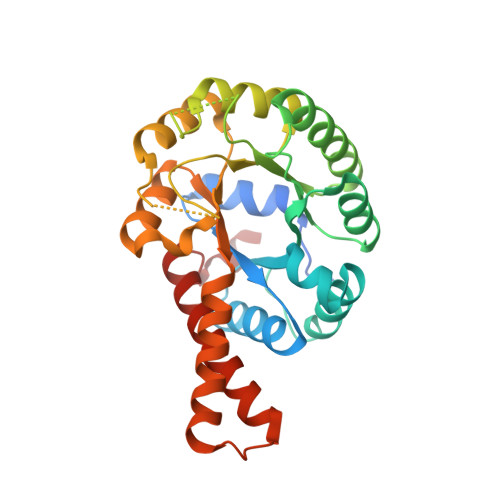Defining the molecular architecture, metal dependence, and distribution of metal-dependent class II sulfofructose-1-phosphate aldolases.
Sharma, M., Kaur, A., Madiedo Soler, N., Lingford, J.P., Epa, R., Goddard-Borger, E.D., Davies, G.J., Williams, S.J.(2023) J Biol Chem 299: 105338-105338
- PubMed: 37838169
- DOI: https://doi.org/10.1016/j.jbc.2023.105338
- Primary Citation of Related Structures:
8Q57, 8Q58, 8Q59, 8Q5A - PubMed Abstract:
Sulfoquinovose (SQ, 6-deoxy-6-sulfoglucose) is a sulfosugar that is the anionic head group of plant, algal, and cyanobacterial sulfolipids: sulfoquinovosyl diacylglycerols. SQ is produced within photosynthetic tissues, forms a major terrestrial reservoir of biosulfur, and is an important species within the biogeochemical sulfur cycle. A major pathway for SQ breakdown is the sulfoglycolytic Embden-Meyerhof-Parnas pathway, which involves cleavage of the 6-carbon chain of the intermediate sulfofructose-1-phosphate (SFP) into dihydroxyacetone and sulfolactaldehyde, catalyzed by class I or II SFP aldolases. While the molecular basis of catalysis is understood for class I SFP aldolases, comparatively little is known about class II SFP aldolases. Here, we report the molecular architecture and biochemical basis of catalysis of two metal-dependent class II SFP aldolases from Hafnia paralvei and Yersinia aldovae. 3D X-ray structures of complexes with substrate SFP and product dihydroxyacetone phosphate reveal a dimer-of-dimers (tetrameric) assembly, the sulfonate-binding pocket, two metal-binding sites, and flexible loops that are implicated in catalysis. Both enzymes were metal-dependent and exhibited high K M values for SFP, consistent with their role in a unidirectional nutrient acquisition pathway. Bioinformatic analysis identified a range of sulfoglycolytic Embden-Meyerhof-Parnas gene clusters containing class I/II SFP aldolases. The class I and II SFP aldolases have mututally exclusive occurrence within Actinobacteria and Firmicutes phyla, respectively, while both classes of enzyme occur within Proteobacteria. This work emphasizes the importance of SQ as a nutrient for diverse bacterial phyla and the different chemical strategies they use to harvest carbon from this sulfosugar.
Organizational Affiliation:
York Structural Biology Laboratory, Department of Chemistry, University of York, York, UK.















